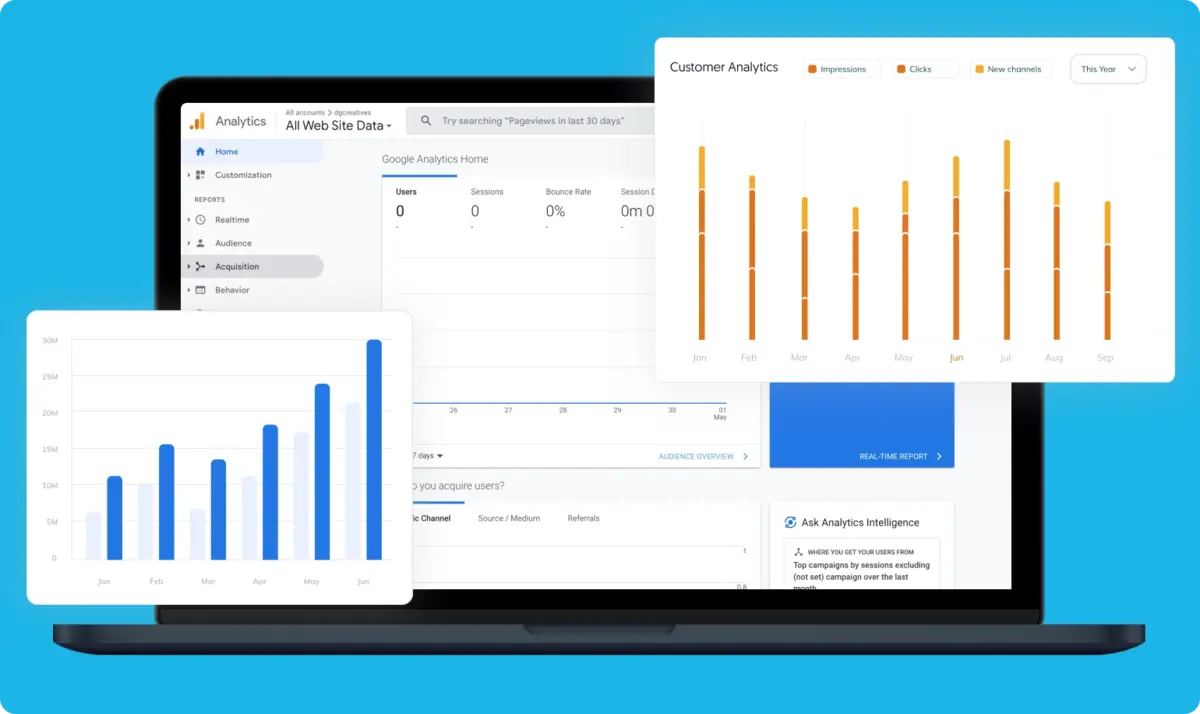
Creating a marketing plan can be a baffling, confusing, and downright terrifying affair.
There you are, staring at a blank document or spreadsheet, wondering where to even begin.
That’s where marketing templates come in handy: they disperse the mist, help you organize your thoughts and goals, and give you a set of instructions to follow along the way.
In this article, we’re looking at how, more exactly, you can use marketing plan templates to build a solid strategy that’s
- Suitable for your business,
- Fully customized for your market, needs, and audience, and
- And carefully calculated to match your goals.
Keep reading to find out more!
Short answer
What is a marketing plan?
A marketing plan is a comprehensive document that details a company’s marketing strategy. It outlines the steps necessary to achieve specific business objectives, including targeting the right audience, choosing effective marketing channels, and allocating resources efficiently. This plan serves as a roadmap for implementing marketing activities that align with the company’s broader goals.
The importance of a marketing plan
Doing marketing without a marketing plan is like walking blindly, on the edge of a cliff. Having a marketing plan, on the other hand, provides you a roadmap for your business reach and growth. It outlines your goals, target audience, and the strategies you will use to reach them.
Having a well-developed marketing plan is essential for any business, big or small. It not only helps you stay organized and on track with your marketing efforts but also allows you to measure your success and make adjustments as needed.
A properly made marketing plan will help you connect the dots between various marketing channels, ensuring your overall marketing strategy is cohesive, consistent, and effective. It also helps you allocate resources appropriately, making the most out of your budget and efforts.
Goal setting and strategic direction in marketing
Setting clear goals is foundational to any marketing plan, providing clear direction for your marketing efforts and benchmarks for success. A marketing plan defines these goals in the context of your business’s overall objectives, ensuring that each marketing activity is aligned with where you want your business to go.
Your marketing plan outline also guides you in selecting the right strategies and tactics, ensuring that your marketing efforts drive toward your business goals efficiently. This strategic alignment is crucial for maximizing return on investment and achieving sustainable growth.
Budgeting and resource allocation
A comprehensive marketing plan plays a pivotal role in budgeting and resource allocation by providing a structured overview of all planned marketing activities and their corresponding costs.
By clearly outlining expected expenses to goals, businesses can prioritize spending, allocate resources more efficiently, and avoid overspending. This strategic approach helps you make sure every dollar spent contributes directly to achieving targeted outcomes, enhancing overall financial management and marketing effectiveness.
Marketing plan structure: Key components and steps to building one
There are as many variations of a marketing strategy template as businesses out there. However, most of them have common key components that make up a complete marketing plan:
1. Business summary and executive summary
The business summary section of a marketing plan provides a brief overview of the business, including its mission statement, core values, and overarching goals. Meanwhile, the Executive Summary offers a concise summary of the entire marketing plan, highlighting its main points and overall strategy.
2. Market research
Market research in a marketing plan underpins strategic decision-making by offering critical insights into industry trends, target audience behaviors, and competitive landscapes. It provides businesses with the data they need to tailor their marketing strategies effectively, ensuring they resonate with the intended audience and stand out in the market.

3. Competitive research
Competitive research involves analyzing and understanding your competitors’ strategies, strengths, and weaknesses. It enables a business to identify market gaps and opportunities for differentiation, ensuring a competitive edge in its marketing efforts.
4. Target audience and buyer personas
Identifying and understanding your target audience is essential for crafting effective marketing strategies. It involves analyzing demographics, interests, and behaviors to create tailored messages that resonate deeply with potential customers.
On the other hand, buyer personas are a powerful tool for understanding your target audience and guiding your marketing efforts in the right direction. They represent a semi-fictional representation of your ideal customer, incorporating real data and market research to create a detailed profile. This exercise helps you better understand their needs, motivations, and pain points, providing crucial insights for crafting relevant marketing messages.
You can collect all the information for your target audience documentation from various sources, like:
Google Analytics
Google Analytics provides invaluable insights into user behavior, including visitor demographics, how users find and interact with your site, and which content keeps them engaged.
Social media analytics
Social media analytics offer detailed data on audience engagement, preferences, and demographics, helping you understand who interacts with your brand and how they do so.
Customer feedback and surveys
Customer feedback and surveys are direct sources of insights into what your target audience thinks and feels about your brand, providing key data on customer satisfaction, preferences, and areas for improvement.
CRM and sales data
CRM (Customer Relationship Management) and sales data provide extensive information on customer interactions, purchase history, and support queries, allowing for a detailed analysis of customer behavior and preferences.

5. Industry reports and market analyses
Industry reports and market analyses provide comprehensive insights into market trends, consumer preferences, and emerging opportunities, enabling businesses to strategically position their offerings to meet the demands of their target audience.
6. Competitor customer reviews and feedback forums
Competitor customer reviews sites and feedback forums offer critical insights into what consumers appreciate or dislike about rival offerings, guiding businesses to fine-tune their strategies for competitive advantage.

5. Unique selling proposition
Your unique selling proposition (USP) distills what makes your business stand out from competitors into a clear, compelling message. It’s the core of your brand identity, emphasizing the specific benefits your products or services offer to your target audience.
When writing your unique selling proposition, remember to:
- Highlight what makes you different from competitors
- Focus on the benefits your product or service provides to customers
- Be concise and memorable
6 . Business goals and market analysis
The business goals section lays out specific objectives the company aims to achieve through its marketing efforts, aligning with the company’s broader strategic goals. The market analysis, on the other hand, decomposes the industry landscape, identifying target markets and analyzing competitors to inform strategic direction.
To make sure your business goals and market analysis are correctly set, consider the following as well:
Conducting a SWOT analysis
Conducting a SWOT analysis helps businesses identify their Strengths, Weaknesses, Opportunities, and Threats, providing crucial insights for defining precise business goals and thorough market analysis.
Competitive and target market analysis
Assessing your competitive landscape and understanding your target market allows you to better understand your business’ context, accurately define your business goals, and tailor your market analysis for strategic advantage.
7. Marketing initiatives
At this stage, you should decide on the specific marketing initiatives and activities you want to rely on. If your budget and manpower allow for it, you can focus on multiple main areas. Alternatively, you can focus on a single marketing tactic that aligns with your overall goals and budget.
Here are some examples of marketing initiatives you might want to concentrate on:
Promotions
Promotions are targeted strategies designed to boost customer engagement, drive sales, and increase brand awareness through special offers, discounts, and events.
Partnerships and joint ventures
Forming strategic partnerships and engaging in joint ventures can significantly amplify a business’s market reach and resource base. These collaborations enable businesses to leverage complementary strengths, share risks, and capitalize on shared opportunities for growth and innovation.
Referral strategy
A referral strategy is designed to incentivize existing customers to recommend your products or services to new potential customers, effectively leveraging word-of-mouth. This approach not only expands your customer base, but also strengthens trust and loyalty among existing clients by rewarding them for their referrals.
8. Marketing plan channels
Choosing the right marketing channels is crucial for delivering your message to your target audience in the most effective way. These channels, whether digital (like social media, email, and search engines) or traditional (such as television, print ads, and direct mail), should align with where your audience spends their time and consumes information.
To make sure you choose the right channels for your business, we recommend that you:
- Analyze your target audience’s preferred communication methods.
- Understand which platforms and channels your competitors are utilizing.
- Determine the most cost-effective channels for reaching your target audience.
- Consider the effectiveness and reach of each channel in relation to your business goals.
- Evaluate the scalability of selected channels to grow with your business over time.
- Test and measure the performance of each channel to refine your marketing mix.
- Look into emerging channels and technologies to stay ahead of the curve.
- Ensure alignment between channel selection and your overall brand messaging for consistency.
9. Measurement and KPIs to intreduce in your marketing plan
Setting clear measurement practices and Key Performance Indicators (KPIs) is fundamental to tracking the effectiveness of your marketing strategies. These metrics enable businesses to quantify their success, adjust strategies as needed, and ensure alignment with overarching business goals.
Here are essential tips to keep in mind when setting your marketing metrics:
- Focus on measurable outcomes, such as conversions, leads, and revenue.
- Align your KPIs with your specific business goals.
- Choose a mix of leading (predictive) and lagging (historical) indicators for a comprehensive view of performance.
- Regularly review and adjust your metrics to reflect changes in the market or business environment.

10. Retention strategy
Including a retention (or repeat customer) strategy in your marketing plan is important for two main reasons. First of all, there’s only so many “new customers” you can acquire (so if your entire business strategy is based on acquisition and zero retention, you will grind your business to a halt, eventually).
Secondly, repeat customers tend to spend more than new ones, making them a valuable source of revenue for sustainable growth. They also tend to be more likely to recommend you to their peers. A retention strategy includes tactics for keeping existing customers engaged and loyal, such as loyalty programs or personalized communication.
11. Budget & expected ROI
The budget section outlines the financial resources allocated to implement the marketing plan, ensuring that all strategies and actions align with fiscal constraints. It is paired with an expected ROI (Return on Investment) analysis, which projects the financial benefits of the marketing activities in relation to their costs, guiding decision-makers in optimizing marketing investments for maximum profitability.
How to Create a Marketing Plan | Step-by-Step Guide
If you’re looking to ramp up your brand’s marketing strategy and start reaching a wider audience, you need to know how to create a marketing plan. visme.com made it easy for you with this step-by-step guide.

Marketing plan templates and examples
As a general rule, you want to build and/or adapt your marketing plan to your own business. However, if you are looking for some of the best marketing strategy templates to get inspired from, the following are more than worth your time:
General marketing plan
This template provides a structured approach to crafting a comprehensive marketing plan, incorporating the key components as outlined in the article. Each section is designed to guide you through defining, planning, executing, and measuring the effectiveness of your marketing efforts.
Executive summary
- Brief overview of the marketing plan objectives and strategies.
Business overview
- Description of the business, including mission statement and core values.
Situational analysis
- SWOT analysis (Strengths, Weaknesses, Opportunities, Threats).
- Competitive and target market analysis.
Marketing goals and objectives
- Specific, measurable, achievable, relevant, time-bound (SMART) goals.
- Objectives aligned with business strategy and market opportunities.
Target audience
- Detailed profile of the target market segments.
- Insights into their behaviors, preferences, and needs.
Marketing strategies
- Overview of the chosen marketing initiatives (promotions, partnerships, referral strategy).
- Justification for strategy selection based on Situation Analysis.
Marketing channels
- Identification of primary marketing channels (digital and traditional).
- Rationale for channel selection tailored to target audience and marketing strategies.
Action plan
- Detailed plan for executing marketing initiatives, including timelines and responsible parties.
- Breakdown of activities by marketing channel.
Budget and expected ROI
- Comprehensive budget detailing costs associated with each marketing activity.
- Expected Return on Investment for each initiative and overall marketing plan.
Measurement and KPIs
- Key Performance Indicators for monitoring performance.
- Plan for regular review and adjustment based on KPI results.
Retention strategy
- Tactics for maintaining customer engagement and loyalty (e.g., loyalty points, email newsletter, exclusive offers, etc.)
- Plan for personalized communication and loyalty programs.
Appendix
- Any additional information, such as market research data, historical performance metrics, etc.
Revision history
- Record of updates and changes made to the marketing plan.
Social media marketing plan
This social media marketing plan is designed to outline your social media marketing goals, the tactics you will use to achieve them, and the metrics you will track to gauge your progress. It acts as a detailed roadmap for managing and optimizing your social media strategy to connect with your audience and enhance your brand’s online presence.
Executive summary
- Brief introduction to the social media marketing plan goals and expected outcomes.
Objectives
- Clear, measurable objectives for what the social media efforts aim to achieve (e.g., increase brand awareness, improve engagement, drive website traffic).
Target audience
- Detailed analysis of the target audience specific to social media platforms, including demographics, interests, and online behavior.
Competitive analysis
- Overview of competitors’ presence and performance on social media, identifying gaps and opportunities.
Channel strategy
- Selection of social media platforms (e.g., Facebook, Twitter, Instagram, LinkedIn) based on the target audience and content strategy.
- Rationale for each platform chosen.
Content strategy
- Outline of the types of content to be shared (e.g., blog posts, videos, infographics), reflecting brand identity and audience interests.
- Content calendar with publishing schedule.
Engagement strategy
- Plan for active engagement with the community, including response to comments, messages, and user-generated content.
Influencer collaboration
- Strategy for partnering with influencers to expand reach and credibility.
Paid promotion
- Approach for utilizing paid social media advertising and sponsored content, including budget and targeting criteria.
Measurement and KPIs
- Key Performance Indicators to track the success of social media efforts (e.g., engagement rate, follower growth, website traffic from social media).
Tools and resources
- List of tools for scheduling posts, analytics, graphic design, and community management.
Risk management
- Plan to address potential challenges and reputation management on social media.
Budget
- Detailed budget allocation for each platform, including content creation, paid promotions, and influencer collaborations.
Revision history
- Record of updates and changes made to the social media marketing plan.
Content marketing plan
This content marketing plan will strategically outline the creation, publication, and distribution of content to target audiences, aiming to attract, engage, and retain customers.
Executive summary
- Overview of goals and strategies for the content marketing efforts, emphasizing the plan’s alignment with overall marketing and business objectives.
Objectives
- Define clear, measurable goals for the content marketing strategy, such as increasing organic traffic, enhancing brand awareness, and generating leads.
Target audience
- In-depth analysis of the ideal customer profiles, including demographic information, interests, and pain points, to inform content creation.
Audit and analysis
- Assessment of current content assets and performance to identify strengths, gaps, and opportunities for improvement.
Content pillars and themes
- Establishment of core content pillars that reflect the brand’s authority within its industry, around which a variety of themes and topics will be developed.
Content formats
- Enumeration of content formats to be used, including blog posts, videos, infographics, e-books, and whitepapers, tailored to audience preferences and stages of the buyer’s journey.
Editorial calendar
- A detailed publishing schedule that outlines what content will be produced, when it will be published, and where it will be distributed.
Content creation process
- Description of the workflow for content production, from idea generation and research to writing, editing, and approval.
Distribution channels
- Strategically selected channels for content promotion, such as the company’s website, social media platforms, email newsletters, and third-party publications.
SEO strategy
- Integration of keyword research and SEO best practices into content creation to improve search engine rankings and visibility.
Measurement and KPIs
- Key performance indicators for evaluating the success of content marketing efforts, including traffic metrics, engagement rates, lead generation, and conversion rates.
Budget
- A comprehensive breakdown of the budget allocated for content creation, distribution, and promotion activities.
Risk management
- Identification of potential risks and challenges in content marketing, with preemptive strategies for mitigation.
Tools and resources
- Listing of tools and software that will support the content marketing strategy, from content management systems to analytics and SEO tools.
Revision history
- Record updates and changes made to the content marketing plan, ensuring continuous improvement and adaptation to market changes.
Competitor analysis marketing plan template
This competitor analysis template will enable a systematic evaluation of your competitors’ strategies, strengths, weaknesses, and market positioning to identify opportunities for differentiation and growth.
Executive summary
- Brief overview of the competitive landscape and the purpose of the analysis.
Identifying competitors
- List of primary and secondary competitors in the market.
- Criteria for selection of these competitors (market share, product offerings, geographic presence).
Competitor company overview
- Basic information about each competitor (company size, location, history).
- Summary of the competitor’s mission, values, and market positioning.
Product/service analysis
- Detailed comparison of products/services offered by the company and its competitors.
- Analysis of features, quality, pricing, and warranties/guarantees.
Market share and growth
- Overview of each competitor’s market share and historical growth.
- Analysis of market trends and how competitors are positioned to take advantage of these trends.
Marketing strategies
- Evaluation of competitors’ marketing strategies, including online presence, advertising campaigns, social media strategy, and public relations efforts.
- SWOT (Strengths, Weaknesses, Opportunities, Threats) analysis for each major competitor.
Customer analysis
- Overview of competitors’ target customer segments and customer service strategies.
- Analysis of customer reviews and feedback for insights into strengths and weaknesses.
Sales channels and distribution
- Description of competitors’ distribution channels and sales strategies.
- Comparison with the company’s channels and potential areas for improvement or differentiation.
Financial overview
- Overview of competitors’ financial health, if available (revenue trends, profitability, investment in R&D).
Strategic moves
- Examination of recent strategic moves by competitors (partnerships, acquisitions, product launches).
Summary and recommendations
- Summary of key findings from the competitor analysis.
- Recommended strategies for competitive differentiation and opportunities for growth.
Revision history
- Record of updates and changes made to the competitor analysis template.
How to use marketing plan templates for digital marketing
Creating a marketing plan is about a lot more than just filling out empty cells in a document. Here are some guidelines that will help you make the most of any marketing template:
- Start by personalizing the template to fit your specific business needs and goals.
- Clearly define your target audience before selecting strategies and channels included in the template (see our section about this, above).
- Regularly update and adjust your plan based on market changes, new initiatives, or unexpected results.
- Use the template as a guide, but don’t be afraid to think outside the box and add your own unique strategies and ideas.
- Continuously track and measure performance against KPIs set in the template, adjusting tactics as needed for optimal results.
You are free to go as in-depth as you want with your marketing plan. However, there are a couple of “golden rules” that will help you stay on top of everything (and communicate your plan with clarity):
- Maintain simplicity in your messaging and design to ensure ease of understanding for your target audience.
- Ensure brand consistency across all marketing channels to reinforce brand recognition and loyalty.
- Implement quality control measures for all marketing materials and content to maintain high standards.
- Integrate data across platforms for a unified view of customer interactions and marketing effectiveness.
Leveraging data in marketing strategy
Your marketing strategy should be data-driven and incorporate the use of analytics tools to track and measure success. These insights allow for ongoing optimization and informed decision-making in real time. Some of the key data points to track include:
Website traffic and conversion rates
Understanding your website’s traffic patterns and conversion rates is crucial for evaluating the effectiveness of your online presence and marketing efforts.
Social media engagement and reach
Analyzing social media engagement and reach is essential for assessing how well your content resonates with your audience and spreads across platforms.
Email open and click-through rates
Monitoring email open and click-through rates are critical for determining the impact and effectiveness of your email marketing campaigns.
Advertising campaign performance
Evaluating the performance of advertising campaigns is key to understanding the return on investment and the overall success of the marketing strategies implemented.
Customer retention metrics
Tracking customer retention metrics, such as churn rate and customer lifetime value (CLV), is vital for assessing how effectively your business maintains customer relationships and maximizes revenue from existing clients.
Innovative marketing plan ideas
Creating a marketing plan is one thing.
Presenting it to a board or investor is another.
When you build a marketing plan, you want to focus on getting things correctly: your data, your vision, the information you base your assumptions on, and so on. In short, you’re focusing on the “meat,” the core of your marketing strategy.
When you have to present your strategy, however, it all comes down to:
- Making sure everything is crystal clear, and
- Ensuring your message delivery is flawless from every perspective (including the aesthetic one).
To get there, you might want to consider creative ways of making your marketing plan stand out. For instance, here are some of the more innovative methods of presenting a marketing plan:
Tailor it to your audience
It’s one thing to present your marketing plan to your team and it’s an entirely different thing to present it to a board of investors or at a trade event. Each of these situations requires a different approach. Personalizing your marketing plan to fit the audience can help capture their attention and make the information more relevant and memorable for them.
Use multimedia
You shouldn’t be afraid to use multimedia elements in your marketing plan presentation to make it more engaging and memorable. This could include videos, animations, infographics, and interactive elements.
Create an interactive presentation
Creating an interactive presentation involves integrating elements that allow the audience to engage directly with the content, making the marketing plan more dynamic and engaging. Here are some examples if interactive bits you could include in your marketing plan:
- Quizzes or polls that allow the audience to provide feedback and gauge their own understanding of the material
- Interactive charts and graphs that can be manipulated in real-time
- Virtual reality experiences to showcase products or services in a unique way.
Incorporate storytelling
Storytelling is a powerful tool that can help engage audiences and make your marketing plan more memorable. Consider incorporating storytelling elements such as customer success stories, brand origin, or employee anecdotes to add a personal touch and emotional connection to your plan.
The possibilities are endless when it comes to making your marketing plan presentation creative and engaging. Just remember to:
- Stay clear (never sacrifice clear for clever)
- Keep it relevant to your audience
- Use high-quality visuals and multimedia elements
- Rely on solid, healthy data and assumptions
- Incorporate interactive experiences
Executing and monitoring your marketing plan
Building a marketing plan is a more or less temporary task that takes weeks or months to complete. Executing a marketing plan, however, is an ongoing process of implementing and adjusting tactics to achieve desired results.
Here are some key steps for executing and monitoring your marketing plan:
Implement with precision
Once you have finalized your marketing plan, it’s time to put it into action. Make sure to adhere to the timelines and budgets outlined in your plan, and communicate any changes or delays with your team.
Monitor ongoing performance
Monitoring your marketing performance is crucial for understanding the effectiveness of your tactics and making informed decisions for future campaigns. Use the data points mentioned earlier to track progress and adjust strategies as needed.
Regularly reassess and update
A successful marketing plan is not set in stone. As your business and the market evolves, it’s important to regularly reassess and update your plan to stay relevant and competitive. Continuously monitor industry trends, customer feedback, and competitor strategies to inform updates to your marketing plan.
Make use of technology and automation
In today’s digital age, there are numerous tools and technologies available to help streamline and automate various aspects of your marketing efforts. Utilize these resources to save time and effectively track and analyze data for more informed decision-making.
Stay data driven
The reason data driven marketing is so popular is because you need at least some sort of goalpost, or north star metric, to follow. Stay informed by continuously collecting and analyzing data relevant to your marketing strategies, and use this information to make informed decisions for ongoing optimization and success.
Seek feedback and adapt
It’s important to regularly seek feedback from customers, team members, and stakeholders to understand how your marketing efforts are being received and if any adjustments need to be made. Adaptability is key in executing a successful marketing plan.
It is important to remember no one will ever build a flawless marketing plan from the get go. Even if they do, it won’t be perfect for long. Sooner or later, fine-tuning must be made.
Whether it’s business strategy changes, market changes, or inefficiencies you’ve spotted along the way, revisiting and adjusting your marketing plan is essential for long-term success. Keep an open mind, embrace change, and utilize the above strategies to continuously improve and execute a successful marketing plan.
Maintain brand consistency when creating a marketing plan
One element that frequently tends to slip away in marketing plan implementations is brand consistency. It’s easy to see why it happens: when your marketing plan is thick and demanding, and your team is lean and busy, some elements may be overlooked or unintentionally altered. Yet, maintaining brand consistency is crucial in maintaining a strong and recognizable brand identity that resonates with customers.
Thankfully, there are small things you can do to make things easier (for yourself and for the rest of the organization.) For instance, implementing a WiseStamp email signature can help ensure that all team members have a consistent, professional email signature that includes your company’s branding and messaging.
Marketing plans, no easy way
Many will promise marketing miracles encapsulated in a template. But few will actually tell you the truth that marketing plans are hard work – from collecting data, building a plan based on that data, refining your plan, and executing on that plan.
It’s also essential work. And brilliant work. And incredibly rewarding work. Which is why it’s vital for the success of your marketing efforts, combined.
Marketing plan templates can help you find your focus in what might seem like an ocean of questions, doubts, and potentialities. They won’t fix your marketing efforts, but they will help you get organized and stay on track.
By following the steps described in this article (and the tips we’ve sprinkled along the way), you’ll be able to define your marketing objectives, identify and understand your target audience, conduct thorough market research, outline your tactics and strategies, and execute and monitor your plan for ongoing success.
Remember to continuously adapt, seek feedback, and maintain brand consistency to stay ahead of the competition. With a well-crafted marketing plan in hand, you’re on your way to achieving your business

